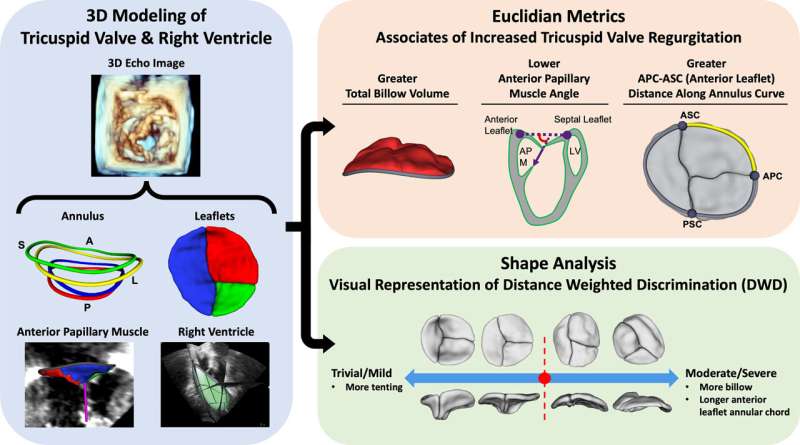This article has been reviewed according to Science X's editorial process and policies. Editors have highlighted the following attributes while ensuring the content's credibility:
fact-checked
peer-reviewed publication
trusted source
proofread
Researchers find structural heart valve differences associated with greater tricuspid regurgitation

Using 3D imaging, researchers in the Cardiac Center at Children's Hospital of Philadelphia (CHOP) have found that patients with hypoplastic left heart syndrome (HLHS) experiencing moderate to severe tricuspid regurgitation (TR) have structural differences in their tricuspid valve. However, these structural differences vary across patients with TR, suggesting that a patient-specific approach to surgery—driven by high-quality imaging of the patient's heart anatomy—will lead to the best outcomes. The findings were published in Circulation: Cardiovascular Imaging.
HLHS is a severe congenital heart defect in which the left side of the heart is underdeveloped. In a normal heart, the heart's left side pumps oxygenated blood into the aorta, which carries blood to body. In a child with HLHS, the left ventricle does not do this properly, leading to poor circulation and inadequate oxygenation of the blood, which results in difficulty feeding and breathing. In most cases, the condition is fatal unless it is addressed early.
A child with HLHS will typically undergoes open heart surgery to re-direct the circulation of oxygen-rich blood and oxygen-poor blood, after which the right side of the heart will do the job of the left and pump the oxygenated blood throughout the body. In this redirected circulation, the tricuspid valve (TV) acts as the atrioventricular valve, which connects the right atrium and ventricle.
Because the right side of the heart is responsible for oxygenating the blood in this scenario, tricuspid regurgitation (TR)—when blood leaks back up into the right atrium—is particularly dangerous for these patients and can lead to death.
To investigate whether the structure of the TV varies in association with the severity of TR, the researchers analyzed 100 HLHS patients with a Fontan circulation, using 3D echocardiograms and an image processing platform called SlicerHeart. The researchers found statistically significant associations between TV structure and function, but they also observed significant heterogeneity in the TV structure in patients with HLHS with a Fontan circulation.
"The heterogeneity we observed in these patients—and characterized using shape-based methods based on our imaging data—suggests that an image-derived, patient-specific approach to surgical planning may be needed to achieve optimal outcomes in this challenging population," said senior study author Matthew A. Jolley, MD, an attending anesthesiologist with the Division of Cardiothoracic Anesthesiology at Children's Hospital of Philadelphia.
"We have also released the novel valve modeling software we used to perform this research, which was led by Hannah Nam here in the Jolley Lab, to facilitate transparent and reproducible valve science in order to help more patients with this condition."
More information: Hannah H. Nam et al, Modeling of the Tricuspid Valve and Right Ventricle in Hypoplastic Left Heart Syndrome With a Fontan Circulation, Circulation: Cardiovascular Imaging (2023). DOI: 10.1161/CIRCIMAGING.122.014671





















